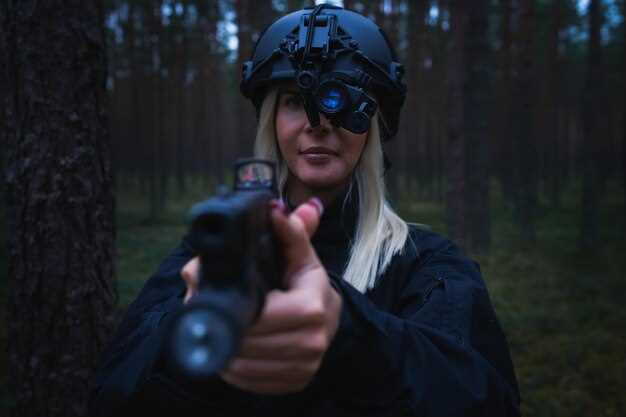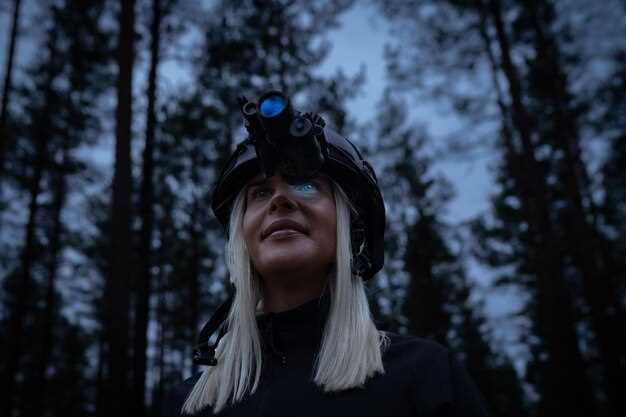
In the realm of night vision technology, understanding the differences between monocular and binocular devices is crucial for making an informed decision. Both types of equipment serve the same fundamental purpose: enhancing visibility in low-light conditions. However, their design, functionality, and intended applications can vary significantly, warranting careful comparison for potential users.
Monocular night vision devices offer a compact and lightweight solution, making them ideal for those who prioritize portability and ease of use. These single-lens systems are often favored for their ability to provide quick and straightforward observation. On the other hand, binocular night vision devices utilize two lenses, which provide enhanced depth perception and a more immersive viewing experience, appealing to users who require detailed visual accuracy in dark environments.
As we delve deeper into this topic, we will explore the specific advantages and disadvantages of each type, equipping you with the knowledge needed to choose the right night vision device for your needs. The comparison will focus on aspects such as performance, comfort, and the specific scenarios where each device shines, ensuring that you make the most informed decision for your nighttime adventures.
Understanding the Optical Mechanism of Monocular Night Vision
Monocular night vision devices utilize a single lens system to enhance visibility in low-light conditions. The core optical mechanism relies on the principles of light amplification, transforming ambient light, such as moonlight or starlight, into a visible image. This process begins with the objective lens, which captures light from the environment.
The captured light passes through a series of optics, where it is focused onto a photosensitive surface, typically a photocathode. This surface converts photons into electrons, amplifying the light signal significantly. The electrons are then drawn towards a microchannel plate, which multiplies them further by releasing additional electrons upon collision. This cascading effect greatly enhances the brightness of the final image.
The amplified electrons eventually hit a phosphor screen, converting the electron stream back into visible light. The result is a green-tinted image, which is characteristic of night vision devices. This choice of green is due to the human eye’s sensitivity to this color, making it easier to discern details even in the dark.
In comparison to binocular night vision systems, monocular devices offer a more compact and lightweight solution, ideal for users who prioritize portability. However, they may lack depth perception, as the single lens does not provide the stereoscopic vision that binoculars can offer. Understanding these optical mechanisms allows users to appreciate the strengths and limitations of monocular night vision devices, making informed decisions based on their specific night vision needs.
Benefits of Binocular Night Vision for Depth Perception
When it comes to night vision devices, the distinction between monocular and binocular systems is crucial for applications that require precise depth perception. Binocular night vision devices provide significant advantages due to their optics configuration, allowing users to experience a three-dimensional view of their surroundings.
One of the primary benefits of binocular systems is their ability to deliver a more accurate representation of distances. With two lenses working together, binocular devices mimic human vision by utilizing both eyes for depth estimation, leading to superior spatial awareness. This is especially beneficial for activities such as wildlife observation, tactical operations, and search and rescue missions, where understanding the spatial relationship between objects is vital.
In terms of comparison, monocular devices often struggle with depth cues, leading to a flat perception of the environment. In contrast, binocular night vision allows for better judgment of distances, enhancing the user’s overall experience and confidence while navigating in low-light conditions. This dual-eye advantage creates a more immersive experience, making it easier to identify the size and location of objects, thereby minimizing the risk of miscalculations.
Overall, the optical design of binocular night vision devices significantly improves depth perception, making them a superior choice for users who require enhanced situational awareness during nighttime operations.
Weight and Portability: Monocular vs Binocular Analysis
When it comes to night vision optics, weight and portability play a crucial role in determining the best device for various applications. Both monocular and binocular night vision devices have their unique advantages and disadvantages in this regard.
Monocular Night Vision Devices
Monocular devices are typically known for their lightweight and compact design. Here are some key points regarding their weight and portability:
- Lightweight: Most monocular devices weigh significantly less than their binocular counterparts, making them easier to carry during extended use.
- Compact Size: Their smaller size allows for easier storage and handling, fitting comfortably in a pocket or small bag.
- Single-handed Operation: Monoculars can be operated with one hand, freeing the other hand for additional tasks or for holding onto objects for stability.
Binocular Night Vision Devices
Binoculars, while typically heavier and bulkier, bring in certain advantages that can justify their added weight:
- Depth Perception: Equipped with dual optics, binoculars provide enhanced depth perception and a wider field of view, which can be beneficial in various scenarios.
- Stability: The additional support provided by two optical systems can offer increased stability and comfort when using the device for prolonged periods.
- Enhanced Viewing Experience: The immersive experience of using both eyes can aid in observational tasks, making it easier to discern details in low light conditions.
Conclusion
Choosing between monocular and binocular night vision devices involves considering the trade-offs of weight and portability. Monoculars excel in convenience and ease of transport, while binoculars offer a superior viewing experience at the expense of added bulk. Ultimately, the decision should be based on individual needs and intended use.
Cost Comparison: Affordability of Monocular and Binocular Options
When evaluating monocular and binocular night vision devices, affordability is a key consideration for many users. Typically, monocular night vision devices are more budget-friendly than their binocular counterparts. This price discrepancy arises primarily from the design and optics involved in each type of device.
Monoculars generally utilize a single optical channel, which simplifies the manufacturing process and reduces costs. This makes them an attractive option for those seeking an economical solution for nighttime viewing. Additionally, monoculars are often lighter and more compact, offering the added benefit of portability paired with lower price points. Consumers can frequently find entry-level models starting at a fraction of the cost of binoculars.
In contrast, binoculars incorporate two separate optical systems, enabling enhanced depth perception and a more immersive viewing experience. However, this complexity often results in higher prices. Between advanced optics and the inclusion of features such as image stabilization or enhanced resolution, the costs for quality binocular night vision devices can escalate quickly. Users looking for superior performance in low-light conditions will need to consider these factors when budgeting.
Ultimately, the choice between monocular and binocular night vision options will depend on individual needs, preferences, and financial constraints. While monoculars provide an affordable entry point, binoculars offer greater performance at a higher price, making the comparison of costs a critical element of the purchasing decision.
Practical Applications for Monocular Night Vision Devices

Monocular night vision devices offer a range of practical applications due to their compact design and ease of use. These devices are particularly beneficial for individual users who require mobility and versatility in low-light situations.
One significant application is in military and tactical operations. Monoculars allow soldiers to maintain a low profile while observing enemy movements or navigating through dark environments. The lightweight nature of monocular devices makes them easier to carry and handle, enhancing operational efficiency on the field.
In wildlife observation and hunting, monocular night vision devices enable enthusiasts to monitor animal behavior during nocturnal hours. Their portability allows for easy transportation during long treks, while the optics provide a clear view in complete darkness, making them ideal for spotting elusive species without disturbing their habitat.
Security and surveillance are other areas where monocular night vision proves invaluable. Security personnel can use these devices to patrol areas at night, detecting potential threats and monitoring surroundings without attracting attention. The ability to zoom in on distant objects provides an added layer of security for monitoring vulnerable locations.
Moreover, search and rescue operations benefit from the use of monocular night vision technology. Rescuers can locate individuals in dark environments more effectively, enhancing response times and increasing the chances of a successful operation.
In addition, recreational activities such as camping and hiking can be enhanced with monocular night vision devices. Campers can navigate through the wilderness after dark, ensuring safety while exploring or locating items in low-light conditions.
In summary, monocular night vision devices serve a variety of functions across military, wildlife observation, security, search and rescue, and recreational activities. Their comparison to binocular devices reveals advantages in weight and portability, making them a preferred choice for many users. The optics employed in monoculars ensure clarity and performance, solidifying their role in practical applications where vision in low-light conditions is crucial.
Choosing the Right Night Vision Device for Outdoor Activities

When it comes to outdoor activities during low-light conditions, selecting the appropriate night vision device is crucial. The choice primarily comes down to whether to opt for monocular or binocular systems, as they each offer distinct advantages and disadvantages related to optics and usability.
Monocular night vision devices are typically more compact and lightweight, making them easy to carry for activities such as hiking or hunting. Their design allows for one-handed operation, which can be advantageous in situations where agility and quick responses are essential. However, this single-lens approach may lead to a lack of depth perception compared to binocular systems.
On the other hand, binocular night vision devices provide a more immersive viewing experience by utilizing two lenses. This allows for improved depth perception and a wider field of view, which can be beneficial in activities like wildlife observation or search and rescue missions. However, binoculars tend to be bulkier and heavier, potentially causing fatigue during extended use.
Furthermore, when making a decision, consider the optical performance of the devices. Higher-quality optics can significantly enhance clarity and brightness in low-light conditions, which is essential for recognizing details at a distance. Examine specifications such as generation type, resolution, and lens diameter to ensure optimal performance based on your needs.
Ultimately, the choice between monocular and binocular night vision devices should be guided by the specific requirements of your outdoor activities, how you prioritize portability versus depth perception, and the optical quality that will best suit your intended use. Careful consideration of these factors will help you make an informed decision that enhances your nighttime adventures.


